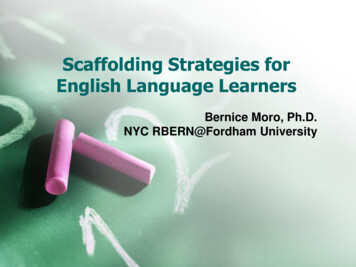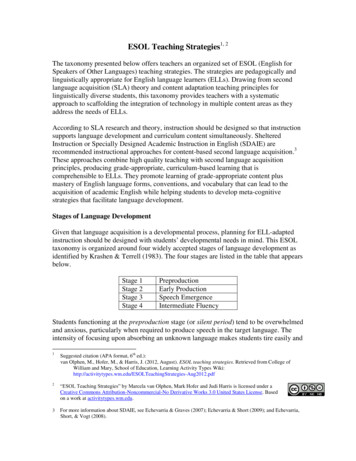
Transcription
Scaffolding Strategies forEnglish Language LearnersBernice Moro, Ph.D.NYC RBERN@Fordham University
Learning & Language Objectives Identify the purpose of scaffolding Describe the six scaffold strategies and thevarious activities that can be used to facilitateacademic language for ELLs Use the Bilingual Common Core languageprogressions to differentiate instruction for ELLs Explain which scaffold strategies and activitiescan address each of the Bilingual CommonCore language progressions for ELLs Use content vocabulary orally and in writing Use oral and written language to describe,identify, explain
Scaffolding: An Overview Scaffolding is a term used to describeappropriate assistance provided to students tolearn what alone would have been too difficultfor them to learn on their own Theorist that influenced this method: Led Vygotsky (1896-1934), RussianPsychologist, introduced concept ofzone of proximal development(ZPD)
Zone of Proximal Development
Scaffolding: An Overview Stephen Krashen, a researcher insecond language acquisition, introducedtheory of comprehensible input Jerome Bruner, researcher in cognitive andeducational psychology, coined the term as adescription of the kind of assistance given bythe teacher or more knowledgeable peer inproviding comprehensible input and moving thelearner into the zone of proximal development
Scaffolding is Scaffolding is tutorial behavior that iscontingent, collaborative andinteractive Contingent: action depends on / influences /is influenced by other actions; Collaborative: end result is jointly achieved; Interactive: includes activities of two or morepeople who are mutually engaged.Walqui, Aida, The International Journal of Bilingual Education and Bilingualism.Vol. 9, No. 2 (2006).
Sources of Scaffolding Four sources of scaffolding: assisted by an expert (e.g. teacher); collaborating with other learners; assisting a lower-level learner; working alone – internalizedpractice, inner speech, etc., areemployed. p. 168Walqui, Aida, The International Journal of Bilingual Education andBilingualism. Vol. 9, No. 2 (2006).
Six Scaffolding Strategies for ELLsModelingDevelopingMetacognitionBridgingText RepresentationContextualizingSchema Building
ModelingStudents need to begiven clear examples ofwhat is required 62/sixscaffoldingstrategiesforells.pdf
Bridging New concepts need to be built onprevious knowledge andunderstanding. Weave newinformation into existing /9/6/4696562/sixscaffoldingstrategiesforells.pdf
Contextualization Provide verbal contextualization bycreating analogies based on studentexperiences. Embed academic language in sensorycontext by using pictures, manipulatives,film [without sound], authentic objectsand source of 696562/sixscaffoldingstrategiesforells.pdf
Schema BuildingSchema are clusters of meaning thatare interconnected. Students need tosee the connections. Some examplesof things a teacher can do: preview the text; note headings, captions, titles of charts, sixscaffoldingstrategiesforells.pdf
TextRepresentationTransform linguistic constructionsfound modeled in one genre intoforms used in another genre.Example: short stories orhistorical essays into dramas orpersonal 96562/sixscaffoldingstrategiesforells.pdf
Developing Metacognition Involves the following: Consciously apply the strategies whileengaging in activities To know and to be aware of the mosteffective strategy for the particularactivity Self –monitor, evaluate and adjustduring performance and to plan futureperformance based on the evaluationafter an 562/sixscaffoldingstrategiesforells.pdf
What are some scaffoldingactivities we can use in theclassroom?
New Terminology!New Language Arts ProgressionsFormerly English as a SecondLanguage Learning StandardsHome Language ArtsProgressionsFormerly Native Language ArtsLearning StandardsNew Levels!5 Levels of LanguageProgressions (Entering,Emerging, Transitioning,Expanding and Commanding)Formerly 4 Levels (Beginning,Intermediate, Advanced andProficient)Table courtesy of EngageNY
Student Performance Descriptors forNew Language Arts Progressions5 dingLISTENINGREADINGRECEPTIVEWhen acquiring a new language, students at each level are able to demonstrate the following with their new language receptively (listening, reading)and productively (speaking, writing). Recognize pre-identifiedtier 1, 2 and 3 wordsfound in the text/context Associate and organizewords with support tounderstand and analyzethe text Marco Recognize pre-identifiedphrases and short sentencesfound in the text/context Associate and organize phrasesand sentences with support tounderstand and analyze text Recognize pre-identifiedtier 1, 2 and 3 wordsfound in the text/context Associate and organizewords with support togain more complex anddetailed understandingand analysis of the text Recognize pre-identifiedphrases and short sentencesfound in the text/context Associate and organize phrasesand sentences with support togain more complex anddetailed understanding andanalysis of the textSPEAKING Use pre-taught one wordanswers Complete sentencestarters Participate in partnershipand teacher lead smallgroup discussions Complete cloze-typeparagraphs Use pre-identified keywordsMarco Recognize informationindependently Associate and organizeinformation independentlyusing teacher provided tools Recognize informationindependently Associate and organizeinformation after teachermodeling to gain more complexand detailed understandingand analysis of the text Recognize informationindependently Associate and organizeinformation independentlyusing teacher provided toolsto gain more complex anddetailed understanding andanalysis of the text Recognize informationindependently Associate and organizeinformation independentlyafter guidance from teacherto gain more complex anddetailed understanding andanalysis of the text Use glossaries of terms toindependently select and usenew vocabulary and phrases Initiate discourse Participate in partnership,small group and whole classdiscussions Lead discourse Participate in partnership,small group and whole classdiscussionsKo Than Nu Recognize informationindependently Associate and organizeinformation independentlywith guidance from teacherDamarisTasfiahDamarisKo Than Nu Use provided key phrases andshort sentences Complete sentence starters Participate in partnership andsmall group discussionsMarco; TasfiahWRITINGPRODUCTIVEMarco Recognize informationindependently Associate and organizeinformation after teachermodeling to understand andanalyze text Develop short paragraphs Use pre-identified key phrasesand short sentencesDamaris; Ko Than NuTasfiah Use word banks to incorporatekey vocabulary and phrasesinto their discussion Share ideas without promptingand support Participate in partnership,small group and whole classdiscussions Develop short essays or text Use word banks to incorporatekey vocabulary and phrasesinto their writingDamaris; Ko Than Nu Develop multiple paragraphessays Use a glossary of terms toindependently select and usenew vocabulary and phrases Develop multiple paragraphessays independentlyTasfiahTable courtesy of EngageNY
Student Performance Descriptors forHome Language Arts Progressions5 dingLISTENINGREADINGRECEPTIVEWhen developing home language, students at each level are able to demonstrate the following with their home language receptively (listening,reading) and productively (speaking, writing). Recognize pre-identifiedphrases and short sentencesfound in the text/context Associate and organizephrases and sentences withsupport to understand andanalyze text Recognize informationindependently Associate and organizeinformation afterteacher modeling tounderstand and analyzetext Recognize informationindependently Associate and organizeinformationindependently usingteacher provided tools Recognize pre-identified tier1, 2 and 3 words found in thetext/context Associate and organize wordswith support to gain morecomplex and detailedunderstanding and analysis ofthe text Recognize pre-identifiedinformation from thetext/context Associate and organizeprovided information togain more complex anddetailed understandingand analysis of the text Recognize informationindependently Associate and organizeinformationindependently usingteacher provided tools togain more complex anddetailed understandingand analysis of the text Use glossaries of terms toindependently select anduse new vocabulary andphrases Initiate discourse Participate in partnership,small group and wholeclass discussionsSPEAKINGWRITINGPRODUCTIVEKo Than Nu Use provided key phrases andshort sentences Complete sentence starters Participate in partnership andsmall group discussions Complete cloze-typeparagraphs Use pre-identified key wordsKo Than NuDamaris Use word banks toincorporate keyvocabulary and phrasesinto their discussion Share ideas withoutprompting and support Participate inpartnership, small groupand whole classdiscussions Develop shortparagraphs Use word banks toincorporate keyvocabulary and phrasesinto writingDamaris; Recognize informationindependently Associate and organizeinformation independentlybased on teacher guidanceKo Than Nu Recognize informationindependently Associate and organizeinformation independently withguidance from teacherMarcoTasfiahDamaris Recognize informationindependently Associate and organizeinformation independentlybased on teacher guidance togain more complex anddetailed understanding andanalysis of the textMarco Recognize informationindependently Associate and organizeinformation independently afterguidance from teacher to gainmore complex and detailedunderstanding and analysis ofthe textTasfiah Use glossaries of terms toindependently select and usenew vocabulary and phrases Initiate and occasionally leaddiscourse Participate in partnership,small group and whole classdiscussions Lead discourse Participate in partnership, smallgroup and whole classdiscussionsMarco; TasfiahDamaris; Ko Than Nu Develop multipleparagraph essays Use a glossary of terms toindependently select anduse new vocabulary andphrasesMarco Develop multiple paragraphessays Use teacher provided tools toproduce more complex anddetailed writing Develop multiple paragraphessays independentlyTasfiahTable courtesy of EngageNY
Essential Questions forReflective Practitioners Who are our students? English language learners/bilinguallearners/all students Levels on new and home language artsprogressions Prior schooling, cultural considerations What are our long-term and short-termgoals/objectives? Content/literacy/new and home languagedevelopmentCourtesy of EngageNY
Essential Questions forReflective Practitioners What can our students do relative to ourgoals/objectives? Content/literacy/new and homelanguage development What is likely to be challenging for ourstudents relative to our goals/objectives? Content/literacy/new and homelanguage developmentCourtesy of EngageNY
Essential Questions forReflective Practitioners What strategies can we use to ensure that all ofour students can engage with the activities weorganize in our classes? Differentiate according to new and homelanguage and other background factors How can we assess our students’ performancerelative to our goals/objectives? Content/literacy/new and home languagedevelopmentCourtesy of EngageNY
Think about your students .What scaffolds canyou provide for them?Think-Pair-Share Activity
Scaffolding Links
Resources EngageNY- http://www.engageny.org/ Meeting Students’ Needs Through iles/resource/attachments/scaffolding student needs.pdf Colorin Colorado- http://www.colorincolorado.org/ Quick Reference Guide for Teachers of English Language L/PDFs/35 QRG Jun 2009.pdf ELL/SDAIE 012/06/EL-SDAIE-Strategies.pdf The GO TO Strategies: Scaffolding Options for Teachers of ELLs- K-12https://www.google.com/search?q ell sdaie strategies&oq ell%2Fsda&aqs chrome.3.69i57j69i58j0l4.13068j0j7&sourceid chrome&espv 210&es sm 93&ie UTF-8 Scaffolding Language/Scaffolding Learning: Teaching SecondLanguage Learner in the Mainstream Classroom. Pauline Gibbons,2002, Heinemann. Scaffolding Instruction for English Language Learners: A ConceptualFramework. Aida Walqui, Vol. 9, No. 2, 2006, The International Journalof Bilingual Education and Bilingualism
Bernice Moro, Ph.D.bmoro@fordham.edu
context by using pictures, manipulatives, film [without sound], authentic objects . Meeting Students’ Needs Through Scaffolding . Scaffolding Instruction for English Language Learners: A Conceptual Framework. Aida W










